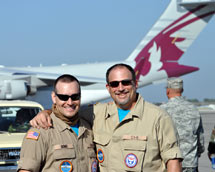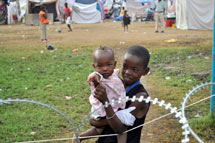
Handy Links
SLAC News Center
SLAC Today
- Subscribe
- Archives: Feb 2006-May 20, 2011
- Archives: May 23, 2011 and later
- Submit Feedback or Story Ideas
- About SLAC Today
SLAC News
Lab News
- Interactions
- Lightsources.org
- ILC NewsLine
- Int'l Science Grid This Week
- Fermilab Today
- Berkeley Lab News
- @brookhaven TODAY
- DOE Pulse
- CERN Courier
- DESY inForm
- US / LHC
SLAC Links
- Emergency
- Safety
- Policy Repository
- Site Entry Form

- Site Maps
- M & O Review
- Computing Status & Calendar
- SLAC Colloquium
- SLACspeak
- SLACspace
- SLAC Logo
- Café Menu
- Flea Market
- Web E-mail
- Marguerite Shuttle
- Discount Commuter Passes
-
Award Reporting Form
- SPIRES
- SciDoc
- Activity Groups
- Library
Stanford
Around the Bay
Brian Sherin Puts His Skills to Work in Haiti
SLAC Deputy Director of ES&H Brian Sherin recently returned from a deployment to Haiti with the U.S. Disaster Medical Assistance Team. He dealt with plenty of horror and disorder during his two-week stay. But somewhere, between setting up temporary medical centers, treating patients, and managing safety and security for the U.S. Department of Health and Human Services, Sherin and his fellow volunteers shared a few lighthearted moments, too.
They slept on the front lawn of the U.S. Embassy for a few days, where security lights were kept on all night. Every morning at 6 a.m., the lights shut off, forcing volunteers to fumble around in semi-darkness until the sun came up. One morning, Sherin's fellow volunteers asked a minister if he could do anything about the situation. The minister jokingly spread out his arms and commanded to the heavens, "Let there be light!"
"About thirty seconds later, we got a magnitude 6.0 aftershock," Sherin said with a laugh.
Sherin, who is a member of the San Francisco Bay Area-based Disaster Medical Assistance Team CA-6, was deployed to Haiti just after the earthquake on Tuesday, January 12. DMAT members are recruited because their "day jobs" provide them with skills applicable for disaster work. DMAT volunteers are on call for a total of two months a year. When activated, they become paid federal employees for short stints.
"DMATs are designed to deliver medical care in post-disaster environments, so that's been the focus of their activity in Haiti," said David Lipin, who is commander of the Bay-area DMAT. "They've seen thousands of patients so far."
As an on-call DMAT member for the month of January, Sherin was notified of his deployment the day after the earthquake struck near Haiti's capital, Port-au-Prince. By Thursday, he and his northern California DMAT team were in Atlanta for meetings, and Friday they arrived in Haiti.
"It looked like pictures of bombed out cities from World War II," Sherin said.
The Port-au-Prince airport, which has only one runway, presented a bottleneck for disaster relief teams trying to get personnel, equipment and food in to the country. Sherin's DMAT teams spent hours waiting for transportation before finally hitching a ride in dump trucks to the U.S. Embassy. For the next couple of days, they camped out on the lawn of the Embassy.
DMAT's purpose is to reestablish medical infrastructure after it has been destroyed. In this case, they needed to set up makeshift hospitals to deal with the huge numbers of injured earthquake survivors.
"You had to have four things: people, equipment, transportation and security," Sherin said. Without all of the necessities in order, Sherin and his fellow DMAT members were forced to wait. "It got a little frustrating," he admitted.
Finally, they headed out to a soccer field, with intent to put up tents for medical treatment. But the field was swamped with homeless earthquake survivors, setting up tents of their own, so the DMAT moved their operation to a nearby school. Creating an impromptu hospital took all night, but the next morning, spirits lifted when some team members helped an expectant mother deliver a healthy baby.
Upon returning to the U.S. Embassy the next day, Sherin was asked to fill a vacancy with the Incident Response Coordination Team, which is part of HHS, as Safety & Security Officer. Stationed at the U.S. Embassy, he served as safety and security liaison to the Department of Defense and visited at least one treatment center every day.
"It was challenging, difficult, but worth it," he said. "I was working 18-hour days, and got a chance to go out and see all of the sites, see what was really going on."
Sherin estimates that the four DMAT teams in Haiti treated around 10,000 victims in the first week. On his last day alone, one treatment center saw around 600 patients. New DMAT members came in at the end of two weeks to take over, sending Sherin and his team home.
"It's oh-so-good to be back home," he said. In his two years with DMAT, this was Sherin's first deployment, and he was proud of helping so many people.
Sherin emphasized how lucky he was to be in his position at the Embassy, with access to e-mail, and how much he appreciated hearing from everyone at SLAC. "It was great getting all the support from the people here," he said. "I was getting supportive e-mails. The communication was great."
óJulie Karceski
SLAC Today, February 3, 2010

